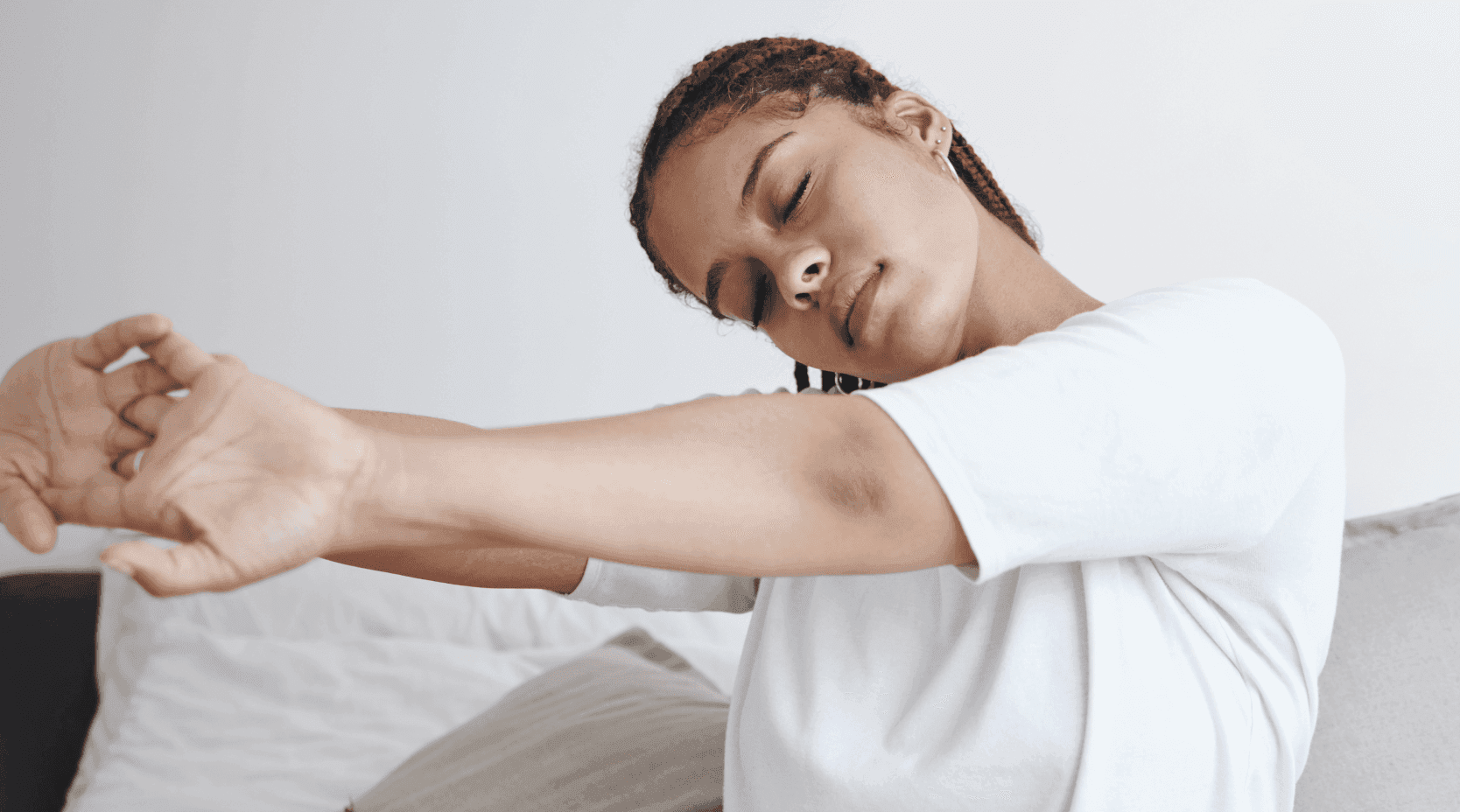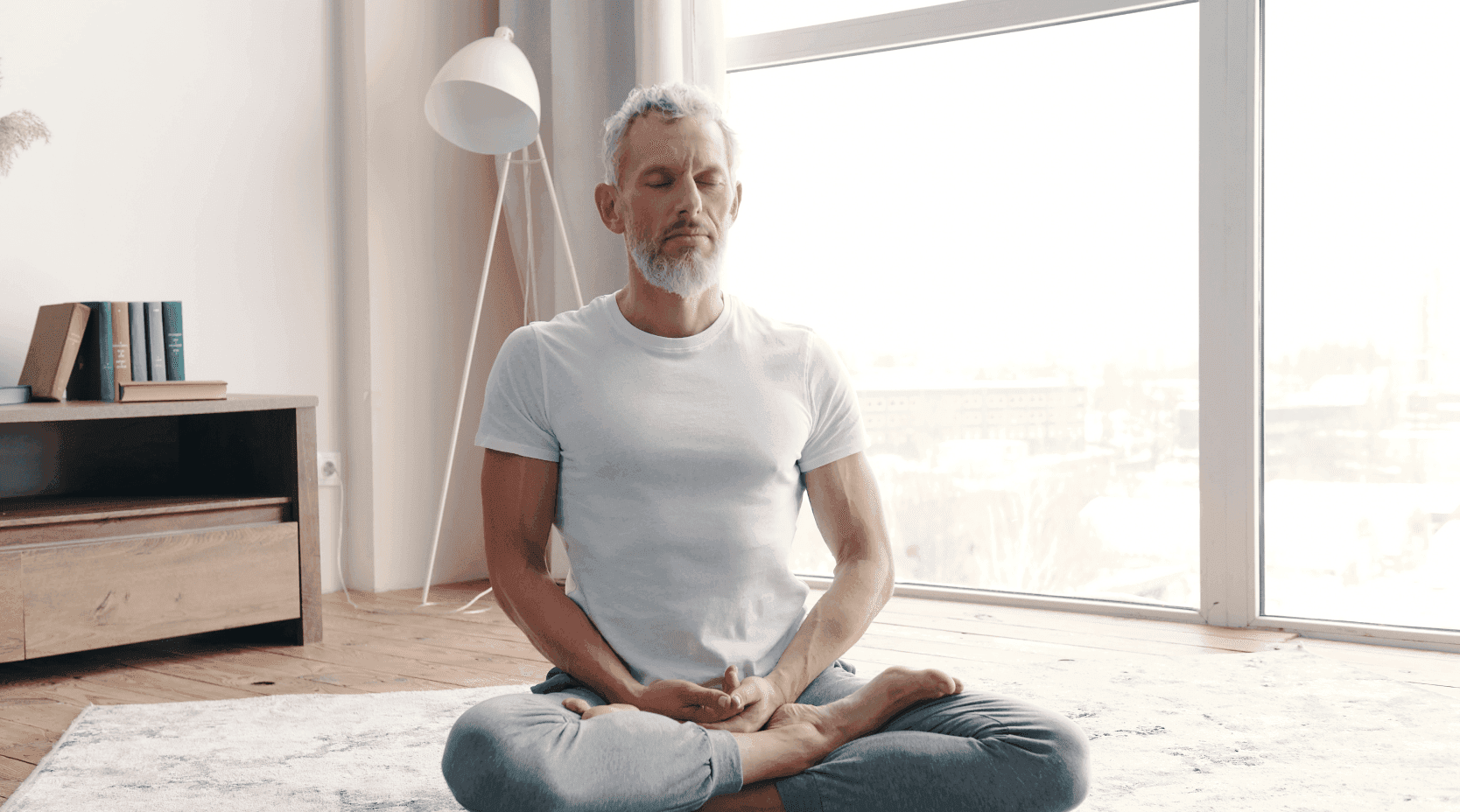October 24, 2025 • min read
Nighttime joint pain: 7 fixes to sleep better
Struggling with nighttime joint pain? Learn why it happens, science-backed fixes, and how to check if digital PT is covered by your employer.
Written by

Director, Clinical Specialists
You’ve powered through the day. Work, errands, life, only to collapse into bed and… ouch. Your joints have other plans. As nighttime comes, your hips stiffen, knees ache, and that nagging lower back pain flares like clockwork. You’re exhausted, but sleep feels miles away.
Sound familiar? You’re not alone. For 50% of adults with musculoskeletal (MSK) pain face this frustrating cycle of “painsomnia,” where joint pain at night and poor sleep feed each other. But here’s the good news: it doesn’t have to be this way. Let’s break down why joint pain and throbbing can be worse at night . You will get actionable, expert-backed fixes to help you reclaim rest.
Why joint and muscle pain is worse at night
Patients with MSK pain often note that their discomfort is worse at night. People often report throbbing pain in their joints at night, arthritis hurts more at night, bones ache more at night, and even that joints ache when waking up just after sleep. But why?
Why do my bones ache at night?
If you’ve ever wondered “why do my bones ache at night?” it often comes down to circulation, pressure, and inflammation. When you lie down, blood flow shifts and fluid can collect around sore joints, creating a feeling of deep bone aching.
Conditions like osteoarthritis, osteoporosis, or previous injuries can heighten this sensitivity. Cooler nighttime temperatures can also tighten muscles and tissues, amplifying discomfort. Gentle stretching, good sleep support, and guided physical therapy can help relieve that deep, throbbing ache over time.
The science behind joint pain at night
- Your body’s natural rhythms shift: At night, cortisol (your anti-inflammatory hormone) dips, while pro-inflammatory proteins like cytokines surge. For arthritis sufferers, this means swelling and stiffness ramp up.
- Prolactin spikes: This hormone, which aids sleep, also amplifies inflammation. Think of it as your immune system overzealously “helping” while you rest.
- Stillness stiffens joints: Lying still reduces blood flow to joints, letting fluid stagnate. Morning creakiness? That’s your joints saying, “Hey, we’re stuck!”
- Stress compounds pain: Ever notice pain feels louder when you’re not distracted? Nighttime’s quiet amplifies discomfort, making it harder to unwind.
7 ways to ease nighttime joint pain
There's hope for managing your sleep better. While you may have developed a pattern of poor sleep that is hard to break, simple lifestyle changes can make a difference. The key to tackling pain at night is to create healthy habits and improve your sleep environment. By making these changes, both the quality and quantity of your sleep can improve. If pain keeps you awake, here are things you can do to ease your symptoms and get some much-needed rest.
1: Pre-Bed Stretches That Don’t Feel Like Work
Skip the intense yoga. Try these PT-approved moves in bed:
- Knee-to-Chest Hugs: Gently pull one knee toward your chest for 15 seconds. Switch sides.
- Seated Spinal Twist: Sit cross-legged, twist gently to one side (hold 10 seconds).
- Neck Glides: Tilt your ear toward your shoulder (no forcing!).
Pro Tip: Pair with deep breathing to signal your body it’s safe to relax.

2: Optimize Your Sleep Setup
- Temperature: Aim for 65–68°F. Too warm? Try moisture-wicking pajamas.
- Mattress: Medium-firm is ideal for most. If yours sags, flip it (yes, adults forget this too).
- Pillow Strategy: Side sleeper? Place a pillow between knees. Back sleeper? Slide one under calves.
3: Heat Therapy: Your Evening Reset Button
Heat relaxes muscles and boosts blood flow to stiff joints. Try:
- A microwavable pad on low for 15 minutes.
- A warm shower before bed (bonus: Epsom salts soothe aches).
Pro tip: Avoid heat if joints are visibly swollen or red.
4: Mindfulness Made Practical
You don’t need to meditate like a monk. It may take some practice before you can meditate effectively (the Mayo Clinic recommends starting with just 5 minutes a day), but with time and patience, it can become an invaluable tool for easing joint pain at night. Try this 5-minute wind-down:
- Lie in bed, hands on ribs.
- Breathe in for 4 counts, out for 6.
- Imagine tension melting from your joints with each exhale.
Studies show this lowers pain perception by 30%—worth a shot, right?

5: Ditch the “Push Through Pain” Mentality
Painkillers mask symptoms; physical therapy fixes the root cause. Example: Weak glutes strain your knees? A PT will strengthen them so your joints can clock out at night.
Sword Health’s Digital PT Includes:
- Video sessions with licensed experts.
- Custom plans for arthritis, sciatica, back pain.
- Employer/insurance coverage for 98% of patients.
Check your eigibility: see if you qualify in 30 seconds.
6: Your Mattress Matters: How to Pick the Right One for Joint Pain
Let’s be real: your mattress isn’t just a place to sleep—it’s a critical tool for joint health. The wrong one can leave you stiff and achy; the right one can feel like a reset button for your body. Here’s how to choose wisely, based on your pain:
For Arthritis Opt for a medium-firm memory foam mattress. It cushions tender joints without sagging, so hips and shoulders don’t sink into awkward positions. Memory foam also distributes weight evenly, easing pressure points.
For Sciatica An adjustable bed frame (or mattress with zoned support) is ideal. Elevating your legs slightly reduces pressure on the sciatic nerve. If that’s out of budget, try a wedge pillow under your knees.
For Chronic Back Pain Look for a hybrid mattress (coils + foam). The coils support your spine’s natural curve, while the foam layer relieves pressure on sensitive areas like the lower back.
Budget-Friendly Hacks:
- Most mattresses last longer if you flip and rotate them every 6 months. Yes, even if it’s a hassle.
- Cooling Sheets: Bamboo or Tencel fabrics wick sweat, reducing inflammation-triggering night sweats.
- Topper Trick: A 3-inch gel-infused memory foam topper (75–75–150) can revive a sagging mattress.
- Pillow Strategy: Place a lumbar pillow under your knees (back sleepers) or between thighs (side sleepers).
7: Move Better, Not Harder: How Daytime Habits Defuse Nighttime Pain
The Science: Movement isn’t about burning calories—it’s about lubricating joints. Synovial fluid (your joints’ “oil”) thickens when you’re sedentary, leading to stiffness. Even small bursts of activity keep it flowing.
PT-Approved Moves for Common Pains:
- Arthritis Knees: Seated leg extensions (10 reps, 2x/day) strengthen quads without impact.
- Stiff Hips: Figure-4 stretch (hold 30 seconds/side) opens tight glutes.
- Sciatica: Cat-Cow stretches (5 mins/day) relieve lower back tension.
Pro Tip: Sword’s Move program offers personalized plans to keep your joints moving and your pain from building.
When to seek help for nighttime joint pain
Persistent painsomnia could signal:
- Arthritis
- Herniated Disc
- Chronic Inflammation
Sword Health’s PTs diagnose and treat these digitally with no clinics, no waiting rooms.
How does Sword Thrive help you stop nighttime joint pain?
When joint pain keeps you awake, recovery should not wait until morning. Sword Thrive is a revolutionary Digital Physical Therapy solution, designed to help people heal from pain quickly, safely, and effectively from the comfort of home. Instead of waiting weeks for a referral or relying only on painkillers, Thrive gives you immediate access to clinically-validated, expert care with the help of an FDA-listed device that delivers real-time feedback.
Every member is matched with a licensed Doctor of Physical Therapy who builds a personalized recovery plan around your specific pain, sleep challenges, and goals. As your body adapts, your plan evolves, helping you steadily reduce pain and reclaim restful sleep.
End your pain with Sword Thrive
Recover faster from the comfort of home with Thrive's clinically-proven digital physical therapy plans.

1. Tell us about you
Share where you’re feeling pain, your medical history, and your lifestyle so we can tailor your care from the start.

2. Choose your clinician
Pick your dedicated Doctor of Physical Therapy. They will guide your recovery and adjust your plan as you progress.

3. Receive your FDA-listed Thrive kit
We send your Thrive Pad (or motion sensors for certain conditions), equipped with AI motion tracking for real-time feedback

4. Recover from home at any time
Follow guided sessions at home with real-time feedback, and support from your matched Doctor of Physical Therapy.
How Thrive helps to end nightime joint pain
- Fast relief when you need it most: Begin care quickly, so pain does not keep compounding.
- Targeted recovery for flare-ups: Whether it is arthritis, hip stiffness, or back pain that spikes at night, Thrive delivers therapy to calm joints and improve comfort.
- Prevention of chronic sleep disruption: Early treatment reduces the risk of persistent “painsomnia” that disrupts health and quality of life.
- Confidence to move and rest again: With expert oversight, you can safely strengthen and restore joint function, making it easier to fall asleep and stay asleep.
Why choose Thrive to end nighttime joint pain
Musculoskeletal conditions are the leading cause of disability and healthcare cost in the U.S.1 Nighttime pain may feel inevitable, but it does not have to control your sleep. Thrive ensures you get the right care at the right time, so pain does not turn into a chronic cycle.
Sword’s Digital Physical Therapy delivers continually proven results validated by multiple clinical studies:
- 67% of members are pain free by program end2
- Up to 70% reduction in surgery intent3
- 47% stop taking painkillers4
- 68% increase in productivity5
With Thrive, you are not just hoping for a good night’s sleep. You are actively taking steps to make it possible.
FAQs: top questions about nighttime joint pain, answered
Does stress worsen nighttime joint pain?
Yes! Stress releases cortisol, which spikes inflammation. Try evening yoga or a 5-minute breathing exercise to unwind.
Are weighted blankets good for joint pain?
For some, the gentle pressure can ease anxiety. But avoid if you have arthritis in hands/shoulders (hard to adjust the blanket).
Why does sciatica flare up at night?
Lying down increases pressure on the sciatic nerve. Fix: Sleep on your less-painful side with a pillow between knees.
Why does arthritis hurt more at night?
Arthritis pain can feel worse at night because your joints get less movement and circulation while you sleep. During the day, activity helps keep joints lubricated and reduces stiffness. When you rest, inflammation can build up around the affected areas, increasing pressure and discomfort. Lower evening levels of natural anti-inflammatory hormones like cortisol may also make pain more noticeable. Add an unsupportive mattress or poor sleep posture, and nighttime arthritis pain can easily intensify.
Why do I have aching joints when sleeping?
Aching joints while sleeping are usually caused by a combination of relaxed muscles, poor sleep position, or existing joint conditions like arthritis or bursitis. When your body slows down overnight, muscles that stabilize your joints aren’t as active, meaning more stress is placed on sensitive areas like hips, knees, or shoulders. Poor-quality sleep can also make pain feel worse by lowering your pain threshold. The right nighttime posture, relaxation techniques, and daily movement routines can help reduce joint stress and improve rest.
Why do I get hip pain at night?
Nighttime hip pain is common and often caused by inflammation, muscle tension, or the way you sleep. Lying on one side for too long can compress the hip joint and surrounding soft tissues, especially if your mattress doesn’t provide enough support. Conditions like arthritis, bursitis, or tendinitis can make that pain worse when you’re at rest. The hip muscles also tighten after long periods of sitting, which can increase stiffness once you lie down. Gentle evening stretches, adjusting your sleep position, or using a supportive cushion between your knees can help relieve pressure and reduce nighttime hip pain.
Why do my knees ache at night?
Aching knees at night often point to joint inflammation or strain from daily activities. Arthritis, tendon irritation, or tight muscles around the knee can all cause pain to flare when you’re still. When you sleep, reduced movement means less circulation and fluid drainage, which can increase stiffness and discomfort. Cold temperatures can also make joints feel more sensitive. Try light stretching before bed, keeping your knees slightly bent with a pillow underneath, and avoiding positions that lock the joint.
Can diet affect joint pain?
Yes! Avoid sugar and processed carbs before bed. Try tart cherry juice as a little nightime elixir to help you sleep (natural melatonin + anti-inflammatory).
Can a bad mattress cause joint pain?
Absolutely. Sagging or overly firm mattresses misalign your spine, straining hips/shoulders. If you wake up stiff or “readjust” constantly, it’s time for a change.
How do I know if I need physical therapy?
If pain disrupts sleep for 2+ weeks, it’s time. Check if Sword Health’s covered for you.
How long before PT improves nighttime pain?
Most patients see changes in 2–4 weeks. Consistency is key, even 10 minutes/day helps.
500,000+ people trust Sword to end their pain
Sword’s at-home care plans may already be covered by your employer, health insurer, or union.
Footnotes
JAMA. 2020;323(9):863–884. doi:10.1001/jama.2020.0734
Sword Book of Business, 2023
Healthcare. 2022;10(8):1595. doi:10.3390/healthcare10081595
Sword Book of Business, H1 2023
Musculoskeletal Science and Practice. 2023 Feb;63:102709. doi:10.1016/j.msksp.2022.102709